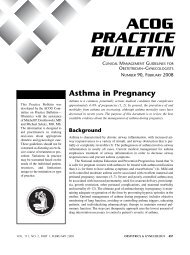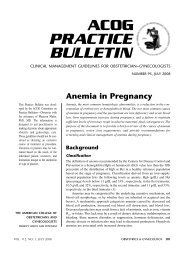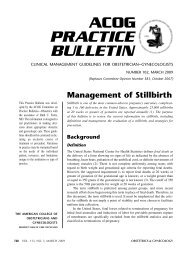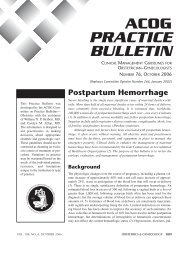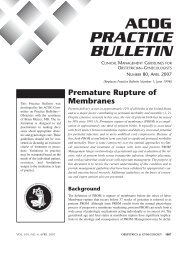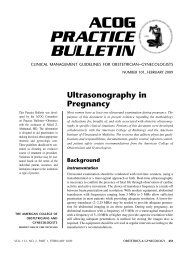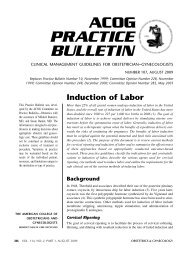ACOG Practice Bulletin: Intrapartum Fetal Heart rate Monitoring
ACOG Practice Bulletin: Intrapartum Fetal Heart rate Monitoring
ACOG Practice Bulletin: Intrapartum Fetal Heart rate Monitoring
- No tags were found...
You also want an ePaper? Increase the reach of your titles
YUMPU automatically turns print PDFs into web optimized ePapers that Google loves.
When the FHR tracing includes recurrent variabledecelerations, amnioinfusion to relieve umbilical cordcompression may be considered (47). A meta-analysis of12 randomized trials that allocated patients to no treatmentor transcervical amnioinfusion noted that placementof fluid in the uterine cavity significantly reducedthe <strong>rate</strong> of decelerations (RR, 0.54; 95% CI, 0.43–0.68)and cesarean delivery for suspected fetal distress (RR,0.35; 95% CI, 0.24–0.52) (48). Because of the lower <strong>rate</strong>of cesarean delivery, amnioinfusion also decreased thelikelihood that either the patient or the newborn will stayin the hospital more than 3 days (48). Amnioinfusion canbe done by bolus or continuous infusion technique. Arandomized trial compared the two techniques of amnioinfusionand concluded that both have a similar ability torelieve recurrent variable decelerations (49).Another common cause of a Category II or CategoryIII FHR pattern is maternal hypotension secondary toregional anesthesia. If maternal hypotension is identifiedand suspected to be secondary to regional anesthesia,treatment with volume expansion or intravenous ephedrineor both is warranted.Summary ofRecommendations andConclusionsThe following recommendations and conclusionsare based on good and consistent scientific evidence(Level A):The false-positive <strong>rate</strong> of EFM for predicting cerebralpalsy is high, at greater than 99%.The use of EFM is associated with an increased<strong>rate</strong> of both vacuum and forceps operative vaginaldelivery, and cesarean delivery for abnormal FHRpatterns or acidosis or both.When the FHR tracing includes recurrent variabledecelerations, amnioinfusion to relieve umbilical cordcompression should be considered.Pulse oximetry has not been demonst<strong>rate</strong>d to be aclinically useful test in evaluating fetal status.The following conclusions are based on limited orinconsistent scientific evidence (Level B):There is high interobserver and intraobserver variabilityin interpretation of FHR tracing.Reinterpretation of the FHR tracing, especially ifthe neonatal outcome is known, may not be reliable.The use of EFM does not result in a reduction ofcerebral palsy.The following recommendations are based onexpert opinion (Level C):A three-tiered system for the categorization of FHRpatterns is recommended.The labor of women with high-risk conditions shouldbe monitored with continuous FHR monitoring.The terms hyperstimulation and hypercontractilityshould be abandoned.References1. Martin JA, Hamilton BE, Sutton PD, Ventura SJ,Menacker F, Munson ML. Births: final data for 2002. NatlVital Stat Rep 2003;52:1–113. (Level II-3)2. Low JA, Pickersgill H, Killen H, Derrick EJ. The predictionand prevention of intrapartum fetal asphyxia in termpregnancies. Am J Obstet Gynecol 2001;184:724–30.(Level II-2)3. Macones GA, Hankins GD, Spong CY, Hauth J, Moore T.The 2008 National Institute of Child Health and HumanDevelopment workshop report on electronic fetal monitoring:update on definitions, interpretation, and researchguidelines. Obstet Gynecol 2008;112:661–6. (Level III)4. Royal College of Obstetricians and Gynaecologists. Theuse of electronic fetal monitoring: the use and interpretationof cardiotocography in intrapartum fetal surveillance.Evidence-based Clinical Guideline No. 8. London (UK):RCOG; 2001. http://www.rcog.org.uk/files/rcog-corp/uploaded-files/NEBEFMGuidelineFinal2may2001.pdf(Level III)5. Liston R, Sawchuck D, Young D. <strong>Fetal</strong> health surveillance:antepartum and intrapartum consensus guideline.Society of Obstetrics and Gynaecologists of Canada;British Columbia Perinatal Health Program [publishederratum appears in J Obstet Gynaecol Can 2007;29:909].J Obstet Gynaecol Can 2007;29(suppl 4):S3–56. (Level III)6. Parer JT, Ikeda T. A framework for standardized managementof intrapartum fetal heart <strong>rate</strong> patterns. Am J ObstetGynecol 2007;197:26.e1–26.e6. (Level III)7. Freeman RK. Problems with intrapartum fetal heart <strong>rate</strong>monitoring interpretation and patient management. ObstetGynecol 2002;100:813–26. (Level III)8. Alfirevic Z, Devane D, Gyte GML. Continuous cardiotocography(CTG) as a form of electronic fetal monitoring(EFM) for fetal assessment during labour. CochraneDatabase of Systematic Reviews 2006, Issue 3. Art. No.:CD006066. DOI: 10.1002/14651858.CD006066. (Metaanalysis)9. Nelson KB, Dambrosia JM, Ting TY, Grether JK.Uncertain value of electronic fetal monitoring in predictingcerebral palsy. N Engl J Med 1996;334:613–8. (LevelII-2)200 <strong>ACOG</strong> <strong>Practice</strong> <strong>Bulletin</strong> <strong>Intrapartum</strong> <strong>Fetal</strong> <strong>Heart</strong> Rate <strong>Monitoring</strong> OBSTETRICS & GYNECOLOGY



